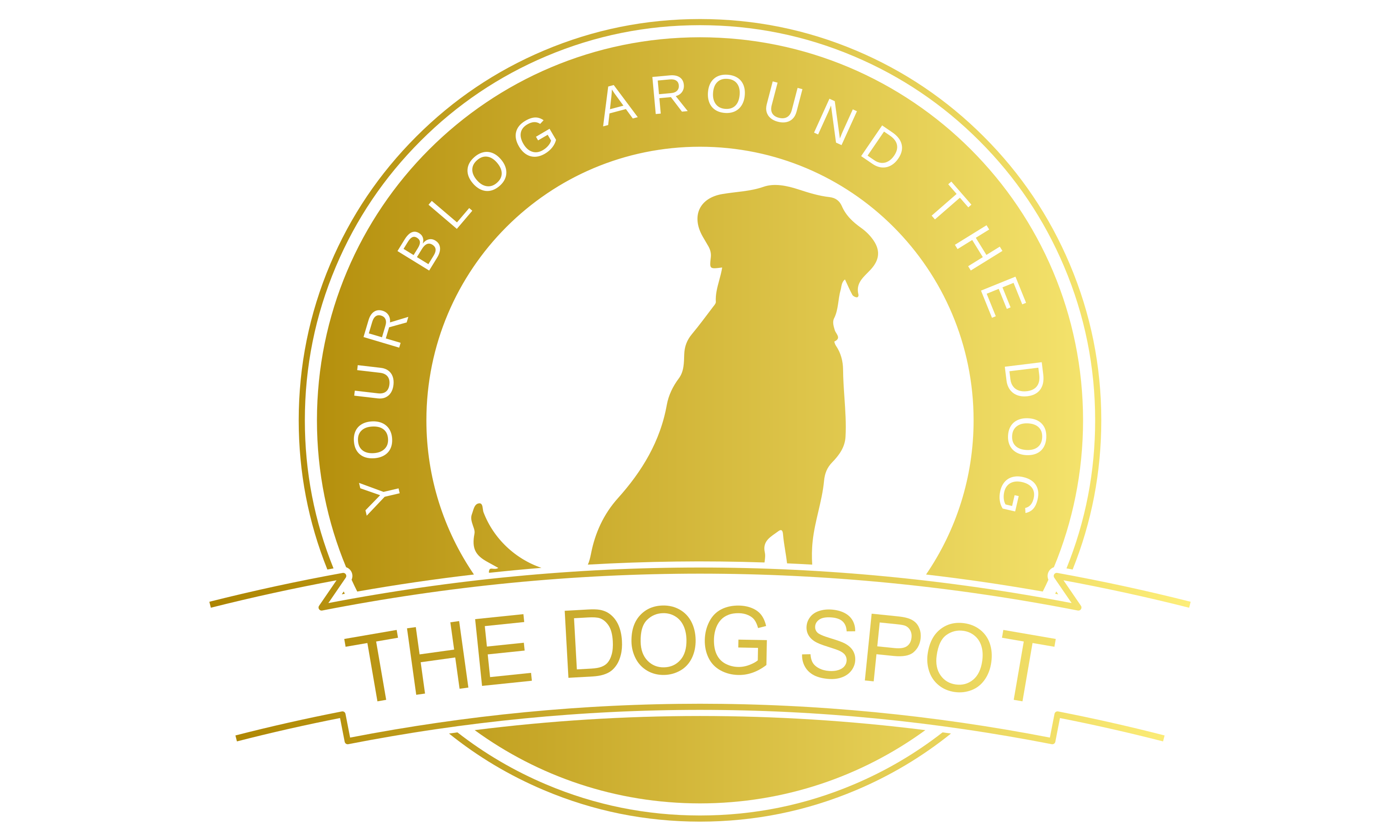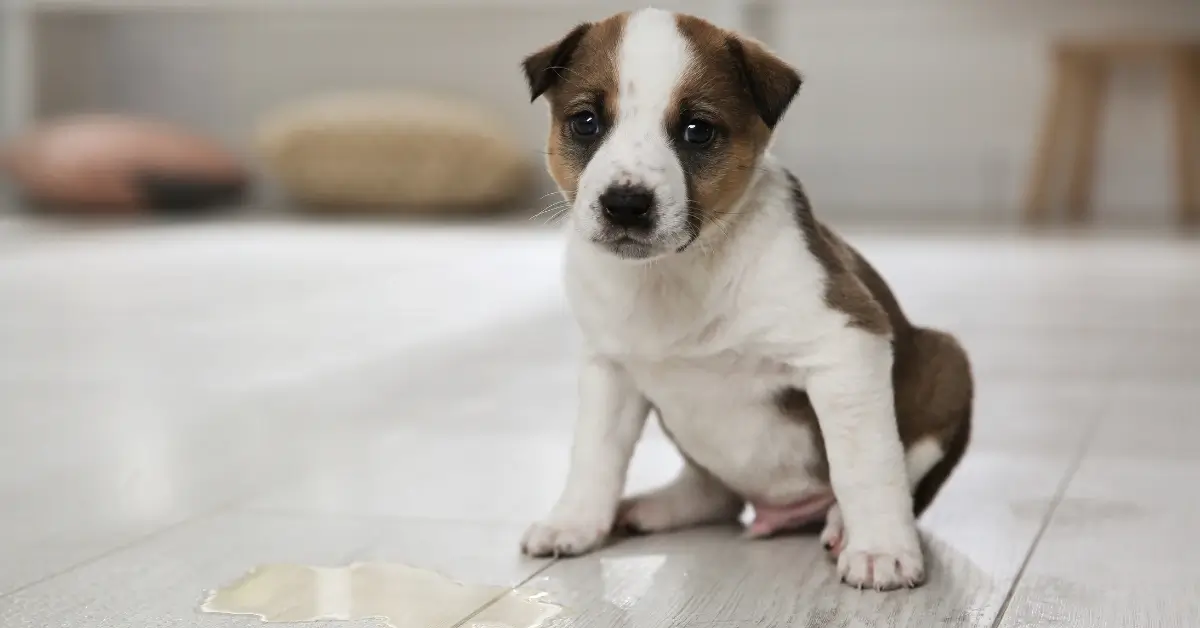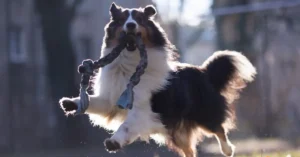We all love our furry friends, but it can be quite frustrating when they suddenly start urinating in the house. In such situations, it’s important to identify the cause of the behavior to work with our dogs and get them back to urinating outdoors. There are several reasons why dogs may pee in the house, and in most cases, the problem can be resolved with a little patience and understanding.
Causes could include a health issue or a change in the dog’s daily routine. Aging or behavioral problems such as anxiety or territorial marking can also be reasons for this behavior. Regardless of the cause, there are some measures we can take to teach our dogs the proper way to address their needs and work on how to stop dog pee in the house.
Pros:
🐶 Unique formula that contains both probiotics and enzymes.
🐶 Safe for use on carpets, upholstery, bedding, clothing, and other water-resistant surfaces.
🐶 Allergen-free
Cons:
🙀Sometimes longer exposure times are necessary
🙀Sometimes more than one application is necessary
🙀We like the scent of the spray, but tastes vary
How To Stop Dog Pee In The House: Understanding Your Pet’s Behavior
As a pet owner, it’s important to understand your dog’s behavior to avoid potential issues like urinating in the house. Therefore, the following section is about how you can recognize triggers and causes of behavioral changes.
Identifying the Trigger
To change your four-legged friend’s unwanted behavior, it’s crucial to identify the triggers. Triggers can be nervous behavior due to fear of situations, external influences, or specific situations such as being alone.
Health-related issues like bladder weakness or incontinence due to age can also underlie the behavior. Therefore, consulting your veterinarian to rule out health problems is essential.

Behavioral Routines
To work on the topic of how to stop dog pee in the house, it’s important to practice the right behaviors with your dog. A common method is crate training since dogs usually prefer not to urinate in their personal space. Also, be sure to establish a consistent feeding and walking routine. This helps your furry friend better understand your expectations and adapt.
Some helpful tips for successful training include:
🐶 Praise when your dog does its business outside. 🐶
🐶Regular walks and outings. 🐶
🐶Introduce commands like “Potty” or similar. 🐶
🐶Allocate patience and time for training. 🐶

Marking Behavior
Marking behavior in dogs can also be a reason why your furry companion is urinating in the house. Most unneutered male dogs have a stronger desire to mark their territory, but spayed/neutered dogs and female dogs can also exhibit this behavior. Common marking behaviors include specific poses, such as leg lifting and urinating at specific locations.
To control marking, it’s important to observe your dog and take consistent action. For unneutered male dogs, neutering may be the best solution to reduce marking. We recommend collaborating with your veterinarian or a behavior therapist to work on how to stop dog pee in the house.
Basics of Dog Care
In this section, we will explain how to stop dog pee in the house, focusing on some key factors: praise and rewards, regular walks, and creating a calm and relaxed environment.
Praise and Rewards
We know that positive reinforcement plays a crucial role in teaching our dogs new behaviors. Reward your dog with treats or affection when they pee outside. Here are some points to consider:
🐩Reward your dog immediately after they have done their business outside.🐕🦺
🐕🦺Use small, tasty treats specifically for training purposes.🐩
🐩Vary the type of reward to increase your dog’s motivation.🐕🦺
Regular Walks
Regular walks are essential to teach your dog to pee outdoors on a specific walking schedule. Providing your dog with outdoor breaks several times a day helps prevent accidents in the house. Here are some tips:
🐕🦺Plan fixed time slots for walks.🐩
🐩Take your dog outside immediately after waking up, eating, and playing.🐕🦺
🐕🦺In rainy or unpleasant weather, use a covered area or shelter.🐩

Creating a Calming Environment
The emotions of the dog play a significant role in indoor peeing. An anxious or excited dog is more likely to urinate inside. Here are some ideas on how to create a relaxed and calming environment:
🐩Ensure that the dog’s sleeping and resting area is cozy and free from disturbing noises (e.g., loud barking from neighbor dogs).🐕🦺
🐕🦺Provide toys and a comfy blanket near the dog’s favorite spot.🐩
🐩Observe if certain factors in the household make your dog anxious or restless, such as loud noises, and try to address them.🐕🦺
By following these pieces of advice and teaching your dog to pee outside, you will soon have a more relaxed home where your four-legged friend enjoys spending time and feels comfortable.
Medical Aspects of Urination in Pets
As responsible pet owners, we are always committed to ensuring the health and well-being of our dogs. A common issue that many dog owners experience is unwanted urination in the house. In this section, we examine the medical factors that can influence urination in pets.

Urinary Tract Infection and Inflammation
One of the main reasons for unwanted urination in the house can be a urinary tract infection (UTI). Some symptoms of this infection include:
- Frequent urination
- Pain during urination
- Blood in the urine
If your dog exhibits these symptoms, it is important to consult a veterinarian immediately.
Common Health Problems
Other common health problems that can lead to your dog urinating in the house include:
- Diabetes: Diabetes can cause your dog to urinate more frequently than normal.
- Dementia: Older dogs may suffer from dementia, affecting their urination behavior.
- Inflammation: Inflammation such as arthritis or joint inflammation can make it difficult for your dog to assume the proper posture for urination.
In all these cases, it is crucial to seek the opinion of a veterinarian for an appropriate diagnosis and treatment, allowing you to successfully address the issue of how to stop dog pee in the house.
Medications and Treatments
Depending on the underlying cause of urinating indoors, the veterinarian may recommend various medications and treatments. For example:
- Antibiotics to treat urinary tract infections.
- Insulin therapy for diabetes.
- Anti-inflammatory medications for inflammation.
Collaborating with your veterinarian is essential to address your furry friend’s individual health problem when dealing with how to stop dog pee in the house. Monitor your dog closely, ensure they have ample opportunities for toileting, and keep an eye on their medical needs.

Understanding Aging and Illness in Dogs
As dog owners, we naturally want our beloved companions to always be healthy. However, it’s important to understand that dogs age over time and may face various health issues. In this section, we will focus on age-related incontinence, the behavior of older dogs, and assessing their health.
Age-Related Incontinence
A common issue in older dogs is age-related incontinence, which can occur for various reasons, such as a decrease in bladder control or weakening of the sphincter muscle. Here are some tips for managing incontinence in older dogs:
- Consult your veterinarian to rule out potential diseases or abnormalities.
- Ensure regular emptying of the bladder to reduce pressure on it.
- Provide the right food to promote healthy digestion and kidney function.
Dog Behavior in Old Age
As dogs age, they may develop perception-related issues like impaired vision or hearing. It’s crucial to be empathetic when interacting with senior dogs. For instance, they may react more sensitively to loud noises or have difficulty making eye contact. Here are some helpful tips for dealing with older dogs:
- Allow your dog to gradually get used to strangers, especially if they are less socially active.
- Use hand signals to facilitate communication if your dog has hearing difficulties.
- Shorten playtimes and walks for your dog, as aging can reduce energy and endurance.
Diseases and Health Assessment
An accurate and regular assessment of an older dog’s health is necessary to detect potential diseases early and provide appropriate treatment. Some common age-related diseases include arthritis, diabetes, and kidney issues. If your furry friend is already spayed or neutered, their life expectancy is often higher, and the risk of certain diseases is lower.
To ensure your dog’s health, you should:
- Schedule regular vet visits for a thorough examination.
- Monitor changes in behavior, weight, or appearance that may indicate potential health issues.
- Make adjustments to diet, exercise, and grooming as needed to improve overall quality of life and well-being.
By being informed about the aging process and potential diseases in dogs, we can provide our older companions with a happy and healthy life and work considerately and patiently on the issue of how to stop dog pee in the house.
We also have more “How To” for you. Does your dog always pull on the leash during walks? Then, we recommend this article. Or does your dog tend to run away outdoors? You might find helpful tips here.
Tips and Tricks to Prevent Indoor Urination

It can be frustrating when your dog pees indoors. Fortunately, there are some tips and tricks that can help address this behavior. In this section, we’ll summarize the key tips and tricks so you know how to stop dog pee in the house.
Firstly, ensure that your furry friend has regular and ample opportunities for walks. The more frequently you take your dog for a stroll, the less likely they are to pee indoors. Observe your dog’s behavior and take them outside immediately if you notice signs such as sniffing, circling, or squatting.
Another effective method is consistent training with your dog. Since your dog was likely house-trained before, it can be helpful to repeat the training and go through the steps again. Reward your four-legged companion for urinating in appropriate outdoor locations.
In specific cases, another method to stop dog pee in the house is using a homemade deterrent spray. Mix ingredients like cayenne pepper, lemon juice, or distilled white vinegar to create a natural spray that discourages your dog from peeing on carpets, furniture, or lawn areas indoors.
Try to pay attention to potential triggers. Find out if there are specific situations that lead your furry friend to pee indoors, such as separation anxiety, sudden noises, or new objects in the house. Identifying potential triggers makes it easier for you to respond to your dog’s needs and solve the problem of how to stop dog pee in the house.
Here’s a summary of our tips to prevent dog pee in the house:
- Regular walking opportunities
- Retraining
- Homemade deterrent spray
- Identifying triggers
We hope our advice helps you, and you soon see success as your dog is less inclined to urinate indoors. Good luck working on this issue with your furry companion!
FAQ
How do you train a dog to stop peeing in the house?
There are several effective methods to train a dog to stop peeing in the house, according to sources on “How To Stop Dog Pee In The House”. Positive reinforcement for outdoor accidents is key. Taking puppies outside regularly and rewarding them with praise and treats when they eliminate outside helps them understand the desired behavior. Cleaning indoor accidents thoroughly with an enzyme cleaner.
What can I give my dog to stop him peeing in the house?
To stop a dog from peeing in the house, it’s best to focus on positive reinforcement and eliminating triggers, according to information on “How To Stop Dog Pee In The House”. Rather than giving medication without veterinary guidance, establish a routine of praise and treats for outdoor relief. Use enzymatic cleaners on accidents and block access to problem areas.
What repels dogs from peeing in the house?
Citrus scents are commonly recommended to help repel dogs from peeing in the house, according to sources on “How To Stop Dog Pee In The House”. Lemon or orange essential oils can be mixed with water and sprayed on areas where accidents occurred. However, training and supervision are most effective for house training success.
What smell stops dogs from peeing?
Many citrus scents like lemon, orange, grapefruit as well as vinegar are suggested as natural deterrents to discourage dogs from peeing according to information covered in “How To Stop Dog Pee In The House”. These pungent smells may be off-putting to dogs and help redirect them to outdoor areas for relief. However, positive reinforcement of proper behavior is the best house training method.
We hope that our contribution on “how to stop dog pee in the house” has been helpful for you. Remember to stay calm, and patience is the key to success. Feel free to share your experiences in the comments.








